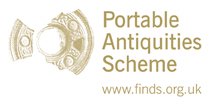Server check!
You are on the training database
Shield
Shields are very rare finds especially complete ones. They are often decorated and hammered into thin sheets of bronze. It is the thin quality of many of the shields that indicates perhaps they were not used as defensive items. It could be that Bronze Age shields were items of prestige and power and were not used in battles and fighting. They are found mostly in Britain and Ireland (interestingly none have been found in France, Belgium or the Netherlands).
Type Nipperwiese
Date: Noted as being contemporary to a similar continental shield dated to the 13th century BC.
Distribution: Eight shields of this type have been found; 2 in Britain, the rest in northern and central Germany.
Description: With a typical diameter of between 38 and 44 cm, and a thickness of the sheet body at 1 to 1.3 mm, these shields are considered to have been the sturdiest type so far discovered. They range between 1.5 to 2.2 kg in weight, and are decorated sparsely, with only two concentric ribs adorning the shield face.
Type Harlech
Date: c.1300-975 BC (Penard to Wilburton metalwork phase) owing to associated finds and metal alloy analysis.
Distribution: Only four of these shields have been found, alongside two more from the close variant Trent form. All found in England and Wales.
Description: The diameters of these artefacts are between 50 and 68.5 cm, with a much more varied thickness of between 0.1 and 1 mm. Two of the shields weigh around 1 kg, whilst an example from the south of England weighed in at 2.75 kg. Similar to Type Nipperwiese shields, the ornamentation on Type Harlech shields are comprised of concentric ribs only, between six and ten, whilst the variant Trent shields, 21 and 63 ribs respectively have been found.
Type Coveney
Date: c.1300-975 BC (Penard to Wilburton metalwork phase) owing to associated finds and metal alloy analysis.
Distribution: Only two so far found, one in Aberdeenshire and one in Cambridgeshire. Uckelmann (Date? Page number?) notes that "Even though they were found far away from each other... they must have been made either in the same place, or one was crafted using the other as a model."
Description: Diameters were recorded as 47.5 and 52.5 cm, with respective metal thicknesses of 0.3-0.5 mm. Both weighed in around 1kg and both feature the same, unique ornamentation. This is comprised of meandering ribs which coil around the shield face, following a concentric line around the shield boss. These ribs end in snakeheads, with punched-in eyes featuring on both. When compared, Uckelmann notes that even though one shield is "larger and has one rib more, the rib-width and the bows of the meander are almost exactly overlapping."
Type Anthenry-Eynsham
Date: Extremely difficult to date as they were all single finds.
Distribution: Six shields of this type have been found, and all have been from Britain.
Description: With diameters ranging from 23 to 35 cm, thicknesses of 0.3-1.2 mm and weights from 0.9 and 1.2 kg; these shields are the smallest sized examples thus found. All show one concentric rib as decoration, and some show one or two rows of bosses. This type is noted as being less homogenous than others, and in contrast to the other types, these shields do not feature a rolled over rim.
Type Yetholm
Example: BM 1873,0210.1 and 1862,1113.1
Date: c.1300-975 BC (Penard to Wilburton metalwork phase) owing to associated finds and metal alloy analysis. Associated heavily with Type Harlech and Coveney shields.
Distribution: Twenty six shields of this type have been recorded, with only one found outside of the British Isles (in Denmark).
Description: The diameter of these shields is quite large, ranging from 55 to 70 cm, with a sheet metal thickness of 0.4 to 0.7 mm. They weigh around 1.2 to 2 kg, with one artefact weighing 2.5 kg. The decoration is regular and comprises alternating concentric rows of bosses and ribs; most shields have 20-30 alternating ribs and small bosses, but a few shields have less rows (four to eleven) with larger bosses.
Example

BM collection number: 1856,0701.1350
Large sheet bronze shield; beaten out from a single disc of bronze; conical central stepped boss, 117mm in Dm., 33mm high; eleven concentric ribs alternating with rows of bosses, rib width 6-7mm, boss Dm. 65mm; rim turned over; handle of tubular sheet-bronze riveted to back, 160mm long; the area where the tabs are usually placed are cut out, as well as an other piece in the lower part of the shield; in the upper part damages of a spearhead and sword stab are visible; central boss is battered.
References
- O'Connor, B. (1980) Cross Channel Relations in the Later Bronze Age. Oxford: British Archaeological Reports S91
- Uckelmann, M. and Mödlinger, M. (2011) Bronze Age Warfare: Manufacture and use of Weaponry. Oxford: British Archaeological Reports S2255


